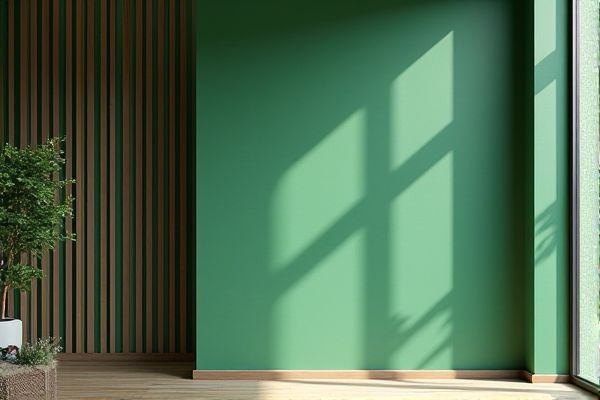
A green wall offers vertical gardening that maximizes space efficiently, enhances air quality, and provides insulation, while a living fence delivers a natural barrier with privacy, wind protection, and aesthetic appeal at ground level. Discover which option best suits Your outdoor space and lifestyle by exploring the differences in this detailed comparison.
Table of Comparison
| Feature | Green Wall | Living Fence |
|---|---|---|
| Definition | Vertical structure covered with plants | Row of closely planted shrubs or trees forming a barrier |
| Primary Purpose | Indoor/outdoor aesthetic enhancement and air purification | Privacy, security, and boundary marking |
| Plant Types | Climbing plants, succulents, mosses | Shrubs, trees, hedges |
| Installation | Requires support structures, irrigation systems | Planted directly in soil or containers |
| Maintenance | Moderate to high, including watering, pruning, fertilizing | Moderate, mainly pruning and pest control |
| Space Requirements | Vertical, minimal ground space | Horizontal, requires land area |
| Environmental Benefits | Improves air quality, reduces heat, absorbs CO2 | Provides habitat, reduces noise, absorbs CO2 |
| Cost | Higher initial and maintenance cost | Lower cost, depending on plant species |
| Longevity | Several years with proper care | Long-lasting if well-maintained |
Introduction to Green Walls and Living Fences
Green walls, also known as vertical gardens, consist of plants grown on vertical surfaces using modular panels or hydroponics, maximizing space for urban greenery. Living fences utilize shrubs or small trees planted closely together to form natural barriers that provide privacy and habitat while enhancing landscape aesthetics. Your choice between them depends on available space, maintenance capacity, and environmental goals.
Key Differences Between Green Walls and Living Fences
Green walls are vertical structures covered with a variety of plant species, often incorporating automated irrigation and support systems, while living fences consist of closely planted shrubs or trees serving as natural barriers or boundaries. Green walls optimize space in urban environments by growing upward and can improve air quality by filtering pollutants on building surfaces, whereas living fences primarily provide privacy, windbreaks, and habitat connectivity at ground level. Both contribute to biodiversity and microclimate regulation, yet green walls demand more technical maintenance compared to the relatively low upkeep of living fences.
Design Principles of Green Walls
Green walls prioritize vertical garden design integrating plants with structural support systems, maximizing space in urban settings. They emphasize water management, root growth, and plant selection suitable for vertical environments, ensuring sustainability and aesthetic appeal. Your green wall design can optimize air quality and insulation, distinguishing it from traditional horizontal living fences.
Design Principles of Living Fences
Living fences emphasize vertical growth using dense shrubs or trees to create natural barriers, enhancing privacy and biodiversity. Their design principles prioritize species selection for durability and adaptability to local climates, ensuring sustainable maintenance. You can optimize a green wall by contrast, which relies more on vertical planting structures, maximizing limited space while promoting air purification and aesthetics.
Environmental Benefits Comparison
Green walls improve urban air quality by filtering pollutants and reducing heat through increased surface area of vegetation, while living fences offer enhanced biodiversity and natural habitat connectivity. Living fences also provide erosion control and support local wildlife corridors, whereas green walls contribute significantly to energy savings by insulating buildings. Your choice depends on prioritizing air purification and energy efficiency or promoting ecosystem support and soil stability.
Aesthetic and Visual Appeal
Green walls offer a sleek, vertical aesthetic that enhances urban spaces with lush, vibrant greenery, blending seamlessly with modern architecture. Living fences provide a natural, organic boundary, creating a charming, textured visual that complements traditional garden settings. Your choice depends on whether you prefer the striking, space-saving design of a green wall or the classic, immersive feel of a living fence for your outdoor space.
Space and Installation Requirements
Green walls require vertical structures such as frames or panels to support plant growth, making them ideal for limited floor space areas in urban environments. Living fences need more horizontal ground space as they involve planting hedges or shrubs directly into the soil or containers along property lines. Installation of green walls often involves complex systems for irrigation and structural support, whereas living fences typically require simpler planting and maintenance processes.
Maintenance and Longevity
Green walls require regular irrigation, nutrient monitoring, and periodic pruning to prevent plant overgrowth and structural damage, but they can last 10 to 15 years with proper care. Living fences need consistent trimming and pest control to maintain density and health, with many species providing durable coverage for 20 or more years. Both options depend heavily on plant selection and environmental conditions to optimize maintenance efforts and longevity.
Cost Analysis: Green Wall vs Living Fence
Green walls generally incur higher initial installation costs due to structural support, irrigation systems, and specialized plant materials compared to living fences, which primarily require standard hedge plants and fencing structures. Maintenance expenses for green walls can be significant, involving regular watering, pruning, and system upkeep, whereas living fences typically demand less intensive care and lower long-term maintenance costs. Considering these factors, green walls are often a more costly investment upfront and over time, while living fences present a more budget-friendly option for sustainable landscaping.
Choosing the Best Option for Your Space
Green walls maximize vertical space by providing dense plant coverage ideal for small areas, while living fences offer natural boundaries and privacy with flexible height and thickness options. Your choice depends on available space, maintenance commitment, and desired aesthetic impact, as green walls require regular watering systems, whereas living fences may need pruning and seasonal care. Assess sunlight exposure, soil conditions, and the purpose--whether decorative or functional--to select the best green infrastructure for your environment.
 homyna.com
homyna.com